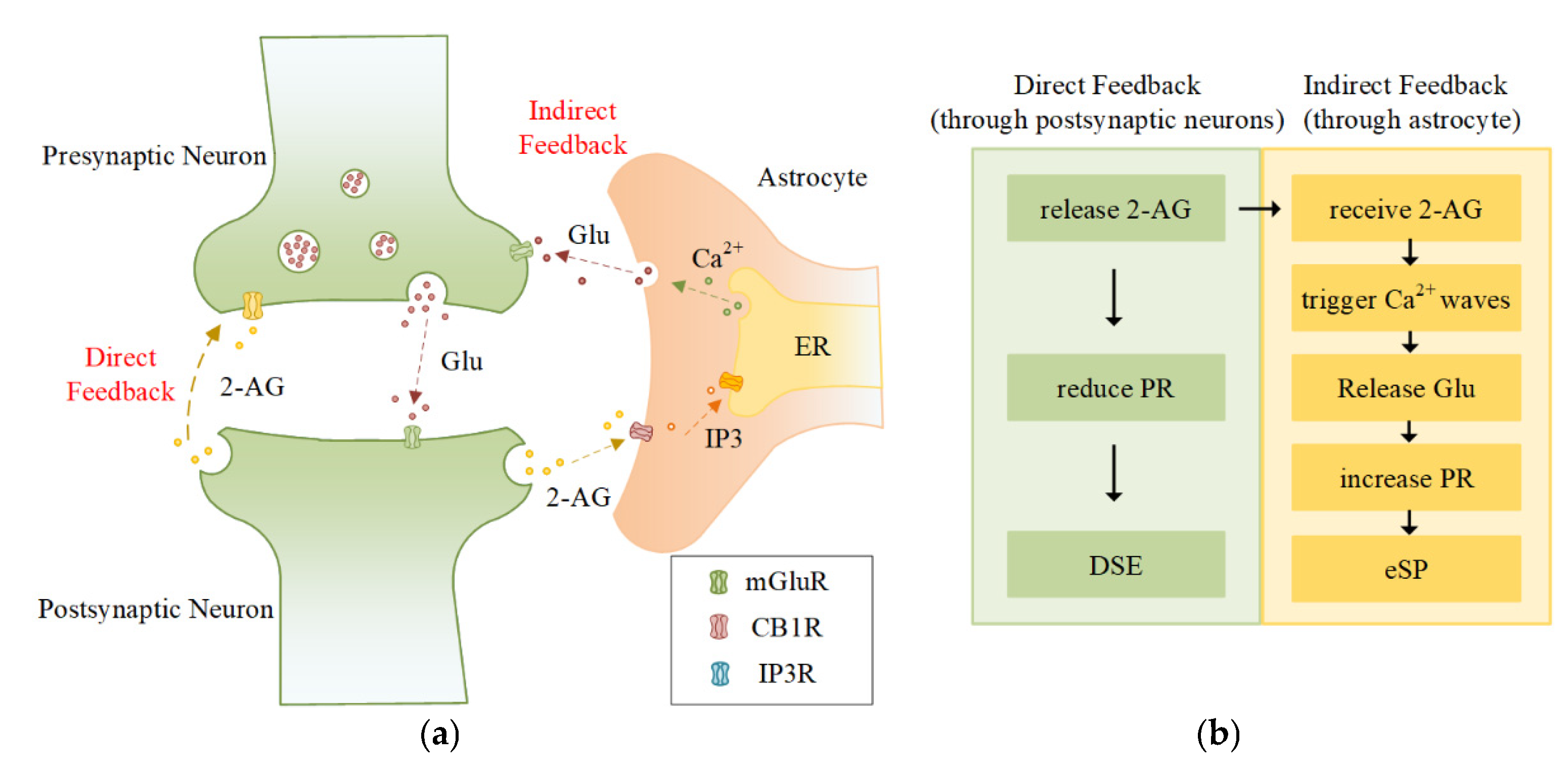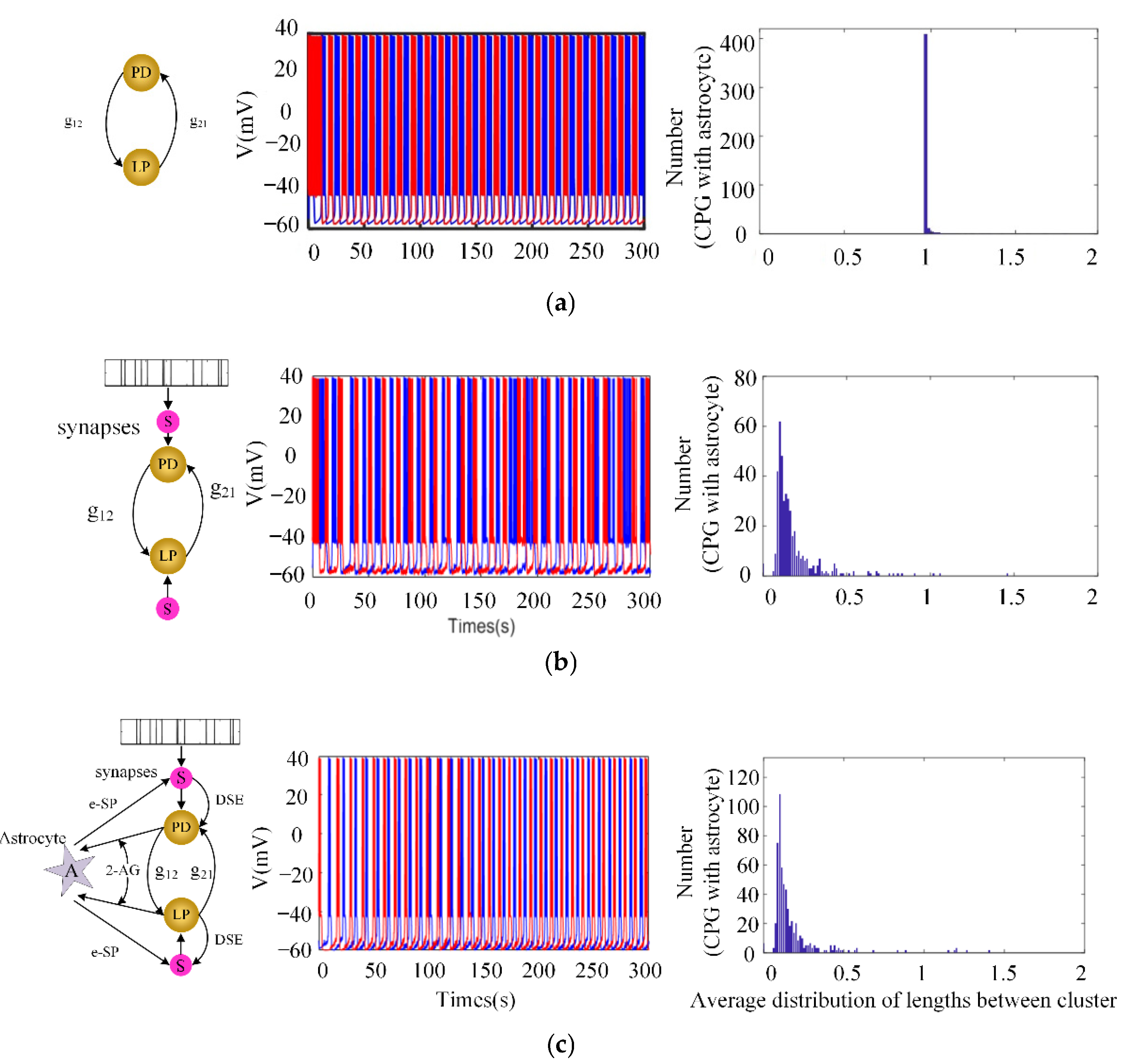Embedded Real-Time Implementation of Bio-Inspired Central Pattern Generator with Self-Repairing Function
Abstract
1. Introduction
2. Background and Relative Works
3. Materials and Methods
3.1. Neuron Model
3.2. Tripartite Synapse Model
3.3. Bio-Inspired Self-Repairing CPG Model (BiSRP-CPG)
3.4. Excitatory Synaptic Activation
4. Simulation of BiSRP-CPG Model
4.1. Robustness against Stochastic Synapses
4.2. Self-Repair in Case of Fault Synapses
5. FPGA Realization of BiSRP-CPG
5.1. Hardware Architecture
5.2. Experimental Results
6. Discussion
- (1)
- A more comprehensive study of the relationship between system-related dynamics and model parameters is needed to better understand how each parameter affects the dynamic behaviors of the astrocyte-mediated CPG internal neurons and the overall CPG network.
- (2)
- The self-repairing ability of BiSRP-CPG should be applied to the fault-tolerant algorithm of electronic system. System reliability should be provided for hardware systems and large-scale equipment through autonomous perception and repair of faults (such as environmental changes and signal loss) [32].
- (3)
- The BiSRP-CPG should be applied to the controller for bio-inspired robot applications. This novel CPG system should be combined with brain machine interface (BMI) technology for exercise rehabilitation [33].
Author Contributions
Funding
Institutional Review Board Statement
Informed Consent Statement
Data Availability Statement
Conflicts of Interest
Appendix A
| Parameter | Value | Parameter | Value |
|---|---|---|---|
| Cm | 0.02 μF | R | 0.1 mm |
| VNa | 40 mV | ks | 50 s−1 |
| Vk | −70 mV | ρ | 0.002 |
| Vb | −58 mV | kβ | 15,000 mM−1 |
| VCa | 150 mV | β | 0.00004 |
| gNa(TTX) | 400 μS | gNa(V) | 0.13 μS |
| gNa | 0.02 μS | gK(TEA) | 10 μS |
| gK | 0.25 μS | gb | 0.18 μS |
| gCa | 1 μS | gCa_Ca | 0.015 μS |
| Esyn | −65 mV | Vfast | 44.7 mV |
| Parameter | Value | Parameter | Value |
|---|---|---|---|
| IP3* | 0.16 μM | kER | 0.1 μM |
| rIP3 | 0.5 μMs−1 | d1 | 0.13 μM |
| τIP3 | 7 s | d2 | 1.049 μM |
| τAG | 10 s | d3 | 0.9434 μM |
| τGlu | 100 ms | d5 | 0.08234 μM |
| eSP | 40 S | C0 | 2 μM |
| rL | 0.11 s−1 | C1 | 0.185 |
| rc | 6 s−1 | a0 | 0.2 μMs−1 |
| rGlu | 10 μMs−1 | meSP | 55 × 103 |
| νER | 0.8 μMs−1 | Ca2+ threshold | 0.3 μM |
| Variables | Value | Variables | Value |
|---|---|---|---|
| Ca2+ | 0.071006 μM | n∞ | 0 |
| h | 0.7791 | m∞ | 0 |
| Jchan | 0 | AG | 0 |
| Jleak | 0 | eSP | 0 |
| Jpump | 0 | IP3 | 0.16 μM |
References
- Weaver, A.L.; Roffman, R.C.; Norris, B.J.; Calabrese, R.L.; Kristan, W. A Role for Compromise: Synaptic Inhibition and Electrical Coupling Interact to Control Phasing in the Leech Heartbeat CPG. Front. Behav. Neurosci. 2010, 4, 1–17. [Google Scholar] [CrossRef] [PubMed]
- Dickinson, P.S. Neuromodulation of Central Pattern Generators in Invertebrates and Vertebrates. Curr. Opin. Neurobiol. 2006, 16, 604–614. [Google Scholar] [CrossRef] [PubMed]
- Martínez-Silva, L.; Manjarrez, E.; Gutiérrez-Ospina, G.; Quevedo, J.N. Electrophysiological Representation of Scratching CPG Activity in the Cerebellum. PLoS ONE 2014, 9, e109936. [Google Scholar] [CrossRef] [PubMed]
- Lafreniere-Roula, M.; McCrea, D.A. Deletions of Rhythmic Motoneuron Activity during Fictive Locomotion and Scratch Provide Clues to the Organization of the Mammalian Central Pattern Generator. J. Neurophysiol. 2005, 94, 1120–1132. [Google Scholar] [CrossRef] [PubMed]
- Minassian, K.; Hofstoetter, U.S.; Dzeladini, F.; Guertin, P.A.; Ijspeert, A. The Human Central Pattern Generator for Locomotion: Does It Exist and Contribute to Walking? Neuroscientist 2017, 23, 649–663. [Google Scholar] [CrossRef]
- Grillner, S.; El Manira, A. Current Principles of Motor Control, with Special Reference to Vertebrate Locomotion. Physiol. Rev. 2020, 100, 271–320. [Google Scholar] [CrossRef]
- Zhong, G.; Shevtsova, N.A.; Rybak, I.A.; Harris-Warrick, R.M. Neuronal Activity in the Isolated Mouse Spinal Cord during Spontaneous Deletions in Fictive Locomotion: Insights into Locomotor Central Pattern Generator Organization. J. Physiol. 2012, 590, 4735–4759. [Google Scholar] [CrossRef]
- Tavoosi, J.; Shirkhani, M.; Abdali, A.; Mohammadzadeh, A.; Nazari, M.; Mobayen, S.; Asad, J.H.; Bartoszewicz, A. A New General Type-2 Fuzzy Predictive Scheme for PID Tuning. Appl. Sci. 2021, 11, 10392. [Google Scholar] [CrossRef]
- Huang, H.; Shirkhani, M.; Tavoosi, J.; Mahmoud, O. A New Intelligent Dynamic Control Method for a Class of Stochastic Nonlinear Systems. Mathematics 2022, 10, 1406. [Google Scholar] [CrossRef]
- Cao, Y.; Lu, Y.; Cai, Y.; Bi, S.; Pan, G. CPG-Fuzzy-Based Control of a Cownose-Ray-like Fish Robot. Ind. Rob. 2019, 46, 779–791. [Google Scholar] [CrossRef]
- Cao, Y.; Xie, Y.; He, Y.; Pan, G.; Huang, Q.; Cao, Y. Bioinspired Central Pattern Generator and T-S Fuzzy Neural Network-Based Control of a Robotic Manta for Depth and Heading Tracking. J. Mar. Sci. Eng. 2022, 10, 758. [Google Scholar] [CrossRef]
- Bushong, E.A.; Martone, M.E.; Jones, Y.Z.; Ellisman, M.H. Protoplasmic Astrocytes in CA1 Stratum Radiatum Occupy Separate Anatomical Domains. J. Neurosci. 2002, 22, 183–192. [Google Scholar] [CrossRef]
- Clarke, L.E.; Barres, B.A. Emerging Roles of Astrocytes in Neural Circuit Development. Nat. Rev. Neurosci. 2013, 14, 311–321. [Google Scholar] [CrossRef]
- Stevens, B. Neuron-Astrocyte Signaling in the Development and Plasticity of Neural Circuits. NeuroSignals 2008, 16, 278–288. [Google Scholar] [CrossRef]
- De Pittà, M.; Brunel, N.; Volterra, A. Astrocytes: Orchestrating Synaptic Plasticity? Neuroscience 2016, 323, 43–61. [Google Scholar] [CrossRef]
- Li, K.; Li, J.; Zheng, J.; Qin, S. Reactive Astrocytes in Neurodegenerative Diseases. Aging Dis. 2019, 10, 664. [Google Scholar] [CrossRef]
- Allen, N.J.; Eroglu, C. Cell Biology of Astrocyte-Synapse Interactions. Neuron 2017, 96, 697–708. [Google Scholar] [CrossRef]
- Kwon, H.S.; Koh, S.H. Neuroinflammation in Neurodegenerative Disorders: The Roles of Microglia and Astrocytes. Transl. Neurodegener. 2020, 9, 42. [Google Scholar] [CrossRef]
- Volman, V.; Ben-Jacob, E.; Levine, H. The Astrocyte as a Gatekeeper of Synaptic Information Transfer. Neural. Comput. 2007, 19, 303–326. [Google Scholar] [CrossRef]
- Wade, J.J.; McDaid, L.J.; Harkin, J.; Crunelli, V.; Kelso, J.A.S.; Beiu, V. Exploring retrograde signaling via astrocytes as a mechanism for self repair. In Proceedings of the International Joint Conference on Neural Networks, San Jose, CA, USA, 31 July–5 August 2011. [Google Scholar]
- Komendantov, A.O.; Kononenko, N.I. Deterministic Chaos in Mathematical Model of Pacemaker Activity in Bursting Neurons of Snail, Helix Pomatia. J. Theor. Biol. 1996, 183, 219–230. [Google Scholar] [CrossRef]
- Wade, J.; McDaid, L.; Harkin, J.; Crunelli, V.; Kelso, S. Self-Repair in a Bidirectionally Coupled Astrocyte-Neuron (AN) System Based on Retrograde Signaling. Front. Comput. Neurosci. 2012, 6, 76. [Google Scholar] [CrossRef]
- Halassa, M.M.; Fellin, T.; Takano, H.; Dong, J.H.; Haydon, P.G. Synaptic Islands Defined by the Territory of a Single Astrocyte. J. Neurosci. 2007, 27, 6473–6477. [Google Scholar] [CrossRef]
- Araque, A.; Parpura, V.; Sanzgiri, R.P.; Haydon, P.G. Tripartite Synapses: Glia, the Unacknowledged Partner. Trends Neurosci. 1999, 22, 208–215. [Google Scholar] [CrossRef]
- Alger, B.E. Retrograde Signaling in the Regulation of Synaptic Transmission: Focus on Endocannabinoids. Prog. Neurobiol. 2002, 68, 247–286. [Google Scholar] [CrossRef]
- Marchant, J.; Callamaras, N.; Parker, I. Initiation of IP3-Mediated Ca2+ Waves in Xenopus Oocytes. EMBO J. 1999, 18, 5285–5299. [Google Scholar] [CrossRef]
- Navarrete, M.; Araque, A. Endocannabinoids Potentiate Synaptic Transmission through Stimulation of Astrocytes. Neuron 2010, 68, 113–126. [Google Scholar] [CrossRef]
- Liu, J.; Harkin, J.; Maguire, L.P.; McDaid, L.J.; Wade, J.J. SPANNER: A Self-Repairing Spiking Neural Network Hardware Architecture. IEEE Trans. Neural Netw. Learn. Syst. 2018, 29, 1287–1300. [Google Scholar] [CrossRef]
- Golowasch, J.; Casey, M.; Abbott, L.F.; Marder, E. Network Stability from Activity-Dependent Regulation of Neuronal Conductances. Neural Comput. 1999, 11, 1079–1096. [Google Scholar] [CrossRef]
- Li, Y.X.; Rinzel, J. Equations for InsP3 Receptor-Mediated [Ca2+](i) Oscillations Derived from a Detailed Kinetic Model: A Hodgkin-Huxley like Formalism. J. Theor. Biol. 1994, 166, 461–473. [Google Scholar] [CrossRef]
- Doloc-Mihu, A.; Calabrese, R.L. A Database of Computational Models of a Half-Center Oscillator for Analyzing How Neuronal Parameters Influence Network Activity. J. Biol. Phys. 2011, 37, 263–283. [Google Scholar] [CrossRef][Green Version]
- Gantel, L.; Berthet, Q.; Amri, E.; Karlov, A.; Upegui, A. Fault-Tolerant FPGA-Based Nanosatellite Balancing High-Performance and Safety for Cryptography Application. Electronics 2021, 10, 2148. [Google Scholar] [CrossRef]
- Saggese, G.; Strollo, A.G.M. A Low Power 1024-Channels Spike Detector Using Latch-Based RAM for Real-Time Brain Silicon Interfaces. Electronics 2021, 10, 3068. [Google Scholar] [CrossRef]













| FPGA Resource Type | Total Logical Resource | Traditional Implementation | Multiplier-Free Implementation |
|---|---|---|---|
| Total logical resource | 114,480 | 70,560 (210%) | 23,101 (20%) |
| Dedicated logical register | 114,480 | 5980 (2%) | 2118 (2%) |
| Pin | 529 | 34 (6%) | 34 (6%) |
| Block RAM resource (bit) | 3,981,312 | 8,251,559 (140%) | 3,057,664 (77%) |
| Embedded multiplier | 532 | 2058 (459%) | 501 (94%) |
| Phase-locked loop circuit | 4 | 1 | 1 |
Publisher’s Note: MDPI stays neutral with regard to jurisdictional claims in published maps and institutional affiliations. |
© 2022 by the authors. Licensee MDPI, Basel, Switzerland. This article is an open access article distributed under the terms and conditions of the Creative Commons Attribution (CC BY) license (https://creativecommons.org/licenses/by/4.0/).
Share and Cite
Xu, J.; Lu, M.; Zhang, Z.; Wei, X. Embedded Real-Time Implementation of Bio-Inspired Central Pattern Generator with Self-Repairing Function. Electronics 2022, 11, 2089. https://doi.org/10.3390/electronics11132089
Xu J, Lu M, Zhang Z, Wei X. Embedded Real-Time Implementation of Bio-Inspired Central Pattern Generator with Self-Repairing Function. Electronics. 2022; 11(13):2089. https://doi.org/10.3390/electronics11132089
Chicago/Turabian StyleXu, Jinda, Meili Lu, Zhen Zhang, and Xile Wei. 2022. "Embedded Real-Time Implementation of Bio-Inspired Central Pattern Generator with Self-Repairing Function" Electronics 11, no. 13: 2089. https://doi.org/10.3390/electronics11132089
APA StyleXu, J., Lu, M., Zhang, Z., & Wei, X. (2022). Embedded Real-Time Implementation of Bio-Inspired Central Pattern Generator with Self-Repairing Function. Electronics, 11(13), 2089. https://doi.org/10.3390/electronics11132089






